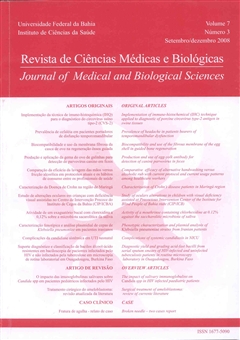Complications of systemic candidiasis in NICU
DOI:
https://doi.org/10.9771/cmbio.v7i3.4472Keywords:
Systemic candidiasis - Neonatal sepsis, Candidaemia complications.Abstract
The aim of this study was to describe the complications of systemic candidiasis in newborns admitted to the Neonatal Intensive Care Unit (NICU) during a 10-year period. An observational study was carried out with 60 newborns admitted at the NICU from 1994 to 2003. The frequency of candidiasis was 1.8% and there was a predominance of male preterm newborns. Low birth weight occurred in 63.3% of the newborns, with 50% of them weighing < 1500 g and among those, 23.3% weighed < 1000g. The most frequent clinical findings were respiratory symptoms, temperature abnormalities, lethargy, hepatomegaly and splenomegaly. Candida species identified were C.albicans (83.3%), C. tropicalis (6.7%), C.parapsilosis (5%) and C.glabrata (1.7%). There were complications in 85% of the cases: urinary tract infection (66.7%), pneumonia (56.7%), meningitis (13.3%), endocarditis (13.3%), deep venous thrombosis (10%), endophthalmitis (6.7%) and renal abscess (1.7%). The mortality rate was 33.3%. The authors concluded that the frequency of complications in systemic candidiasis was high, with lesions detected in several organs and systems, which probably contributed to the high mortality observed in the studied population. The results obtained show the importance of the systematic investigation of multisystemic complications in all newborns with a blood or sterile material culture positive for Candida sp.Downloads
Download data is not yet available.
Downloads
Published
2008-03-02
How to Cite
Pedroso, C. P. A., & Krebs, V. L. J. (2008). Complications of systemic candidiasis in NICU. Journal of Medical and Biological Sciences, 7(3), 280–287. https://doi.org/10.9771/cmbio.v7i3.4472
Issue
Section
ORIGINAL ARTICLES
License
The Journal of Medical and Biological Sciences reserves all copyrights of published works, including translations, allowing, however, their subsequent reproduction as transcription, with proper citation of source, through the Creative Commons license. The periodical has free and free access.


